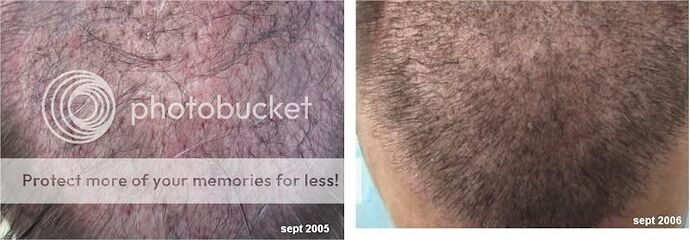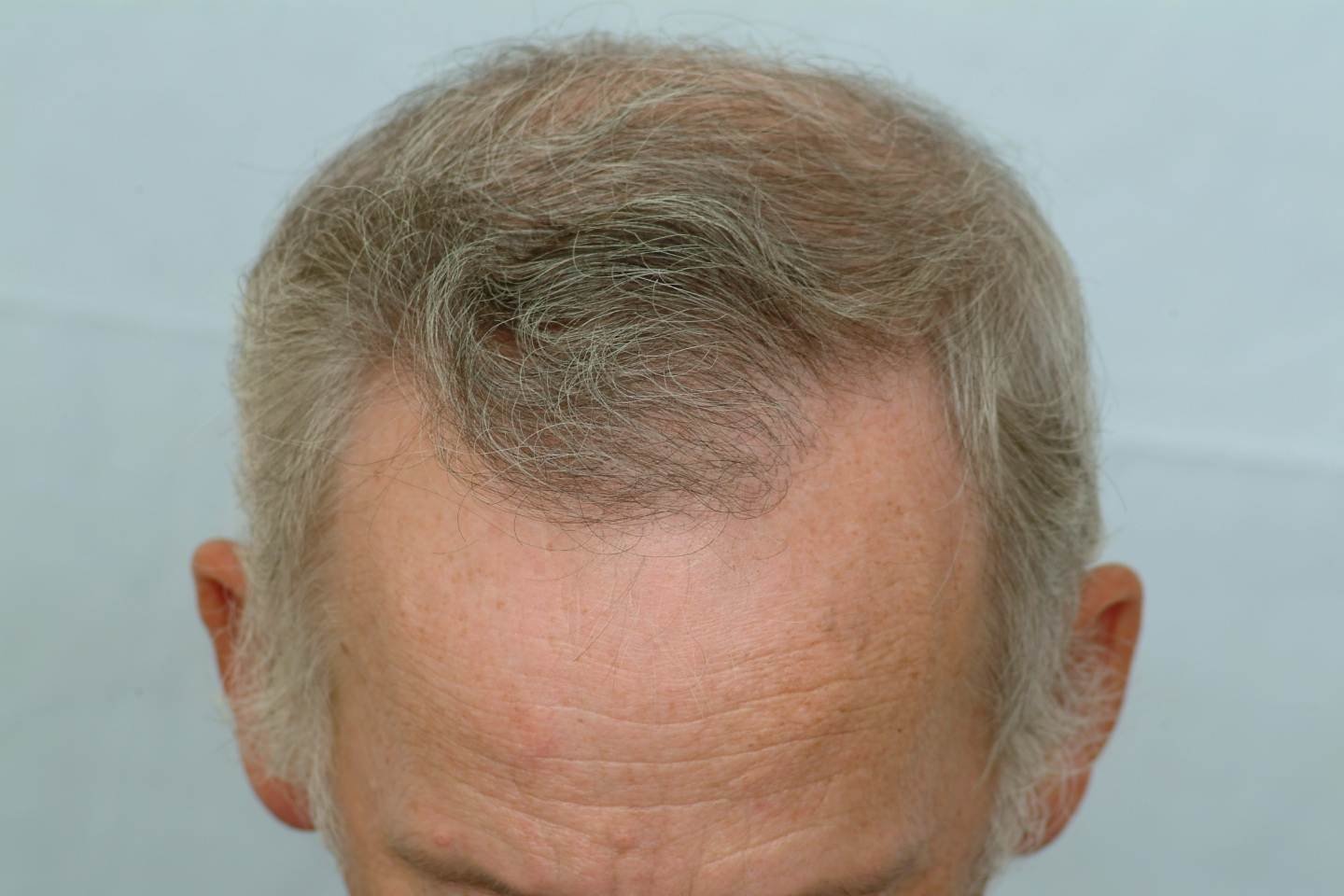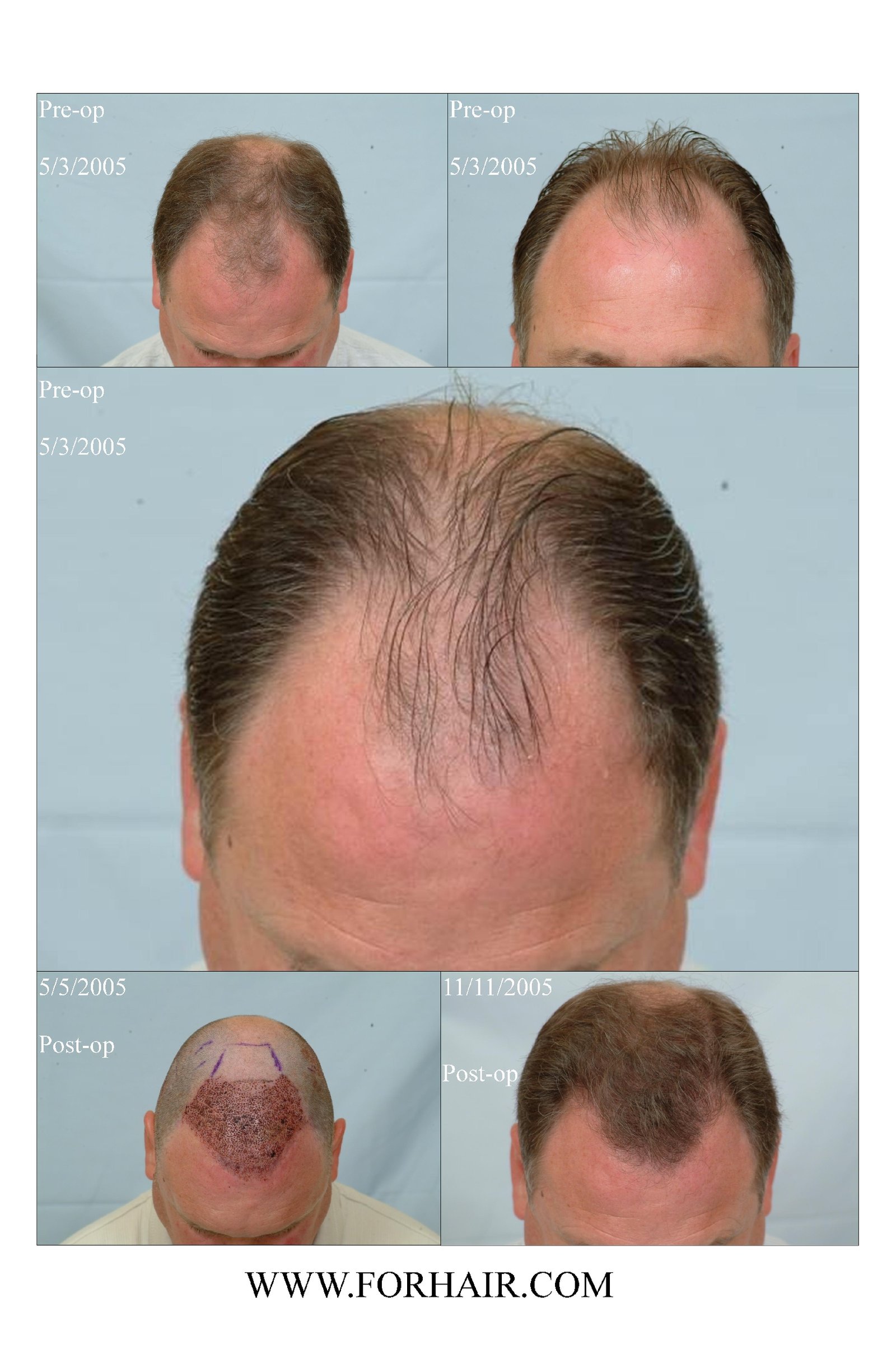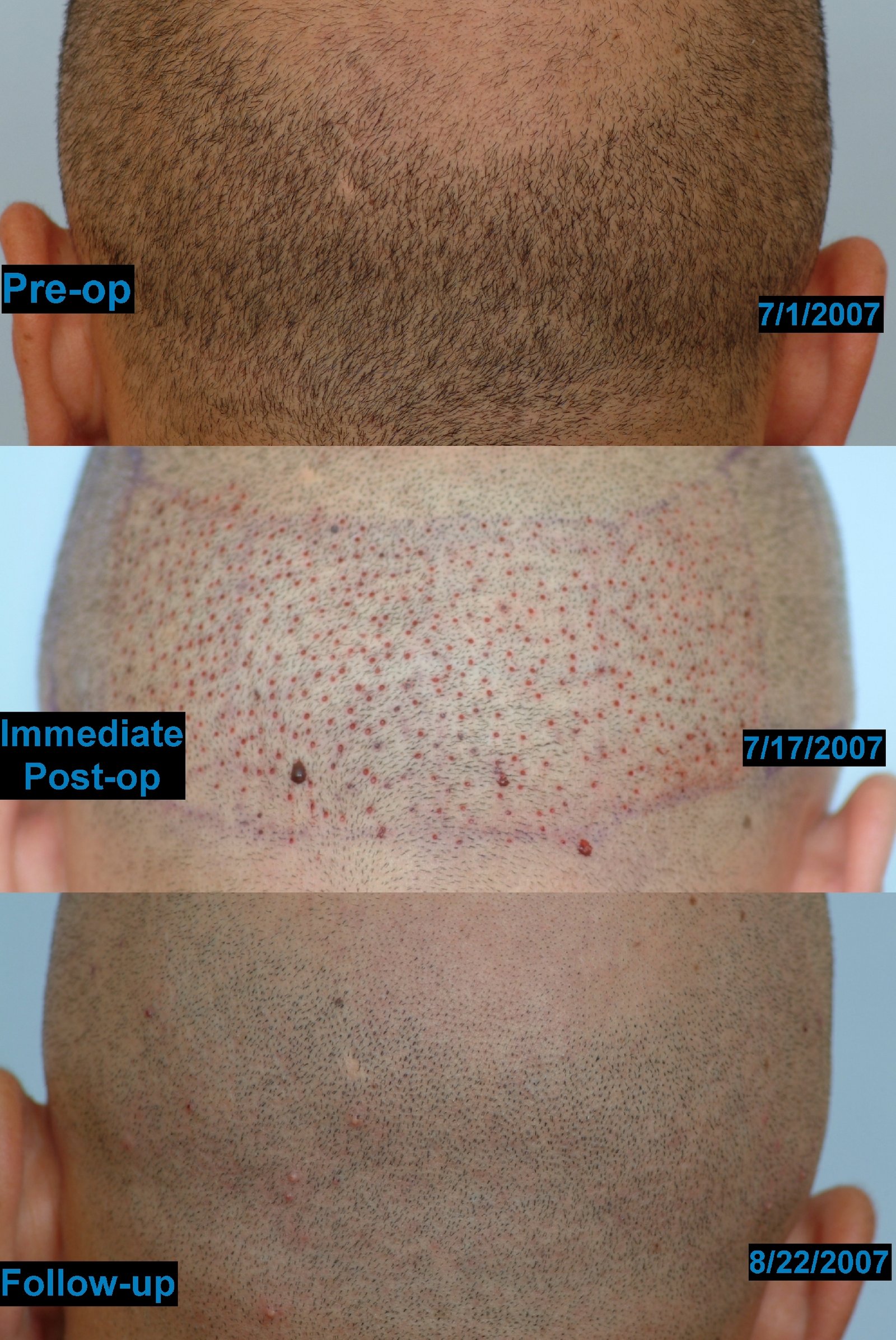Dr. Cole has some nice review of punch sizes in his website in the form of a study if interested:
I think the study is interesting
All that I can say is I’m not sure what size punches were used on me at Dr Cole’s office many years back for a small session. I came out with the ‘white dot sydrome’ from the extraction areas that had to be filled back in by Dr Umar . That accounts for a waste of time and alot of money on the patients part which should not be necessary.
I can also attest to many -many that have contacted me over the years with the same white dot syndrome from his office but for some reason these people are scared to express that openly . I hope the size punch that was used in this study isnt the same that has consistently yielded the ‘white dot syndrome’ in the past. I can say that I have benefited from the 0.75mm and feel much better about it. If a doctor feels anything above that will not produce scarring and he is confident enough about it with a study - it should be put into writing and they are held accountable and required to fix the area of extraction at no charge
19,000 grafts by Dr Umar
www.myhairtransformation.com
Heliboy, we did your procedure in 2003 as I recall and I’ll be happy to tell you the punch sizes we used if you want it disclosed. I recall we did some redistribution of some grafts, as well. I also recall you wanted more work from our office, but you went elsewhere when we could not match the 4.00 per graft price you wanted to pay. In other words, at one point you were quite happy with the results and wanted more. You also had far more pre-existing hair than you show in your pre-Umar surgery photos, but you were shaving the top of your head at the time. White dots are a known and unavoidable risk of FUE in general. No surgeon is immune from them. I’ve seen them in every patient who has come to my office from another FUE clinic. Regardless, I’m sorry to hear you were so distraught over them though you never expressed this to anyone in my office. If you really want to see some ugly scars, check out Luckyman’s chest some time. He still has keloids. I’ve certainly never had a patient form keloids. I have plenty of stories I can pass along if you want to perpertuate this exchange. I’ve had plenty of patients who started at one clinic, but came to mine because results were more important that free or deeply discounted surgery.
White dots are not white scars. they are an absence of hair and circulation. There is no such thing as a surgical procedure that leaves no evidence. Those who want to perpetuate the deceit that the smaller punch produces no evidence of surgery are essentially con men.
the point of this study is quite clear. Punch size does not matter. If you feel better exclusively using a smaller punch, then that’s a personal decision. We’ll be happy to oblige you provided you sign a consent form acknowledgeing that the exclusive use of smaller punches carries a greater risk that you will have a poor result. We have far more results than those who consitently promote the smaller punch. We’ve done over 1000 cases and well over 1.2 million grafts. Patients come to us for results and we deliver. They do not come to us because we promote our procedures with smoke and mirrors or post-surgery photographs that are so small and fuzzy that one cannot accurately assess the results.
»You also had far more pre-existing hair than you show in your pre-Umar surgery photos, but you were shaving the top of your head at the time." I hope since this was brought up here. That these statements can be backed up with photo eviedence by Dr. Cole since it was brought up here for all to see. Patient of course would have to give permission for this. If not all this does is go back and forth. And we can accurately be able to judge final results better .
» Heliboy, we did your procedure in 2003 as I recall and I’ll be happy to
» tell you the punch sizes we used if you want it disclosed. I recall we
» did some redistribution of some grafts, as well. I also recall you wanted
» more work from our office, but you went elsewhere when we could not match
» the 4.00 per graft price you wanted to pay. In other words, at one point
» you were quite happy with the results and wanted more. You also had far
» more pre-existing hair than you show in your pre-Umar surgery photos, but
» you were shaving the top of your head at the time. White dots are a known
» and unavoidable risk of FUE in general. No surgeon is immune from them.
» I’ve seen them in every patient who has come to my office from another FUE
» clinic. Regardless, I’m sorry to hear you were so distraught over them
» though you never expressed this to anyone in my office. If you really want
» to see some ugly scars, check out Luckyman’s chest some time. He still has
» keloids. I’ve certainly never had a patient form keloids. I have plenty
» of stories I can pass along if you want to perpertuate this exchange. I’ve
» had plenty of patients who started at one clinic, but came to mine because
» results were more important that free or deeply discounted surgery.
»
» White dots are not white scars. they are an absence of hair and
» circulation. There is no such thing as a surgical procedure that leaves
» no evidence. Those who want to perpetuate the deceit that the smaller
» punch produces no evidence of surgery are essentially con men.
»
» the point of this study is quite clear. Punch size does not matter. If
» you feel better exclusively using a smaller punch, then that’s a personal
» decision. We’ll be happy to oblige you provided you sign a consent form
» acknowledgeing that the exclusive use of smaller punches carries a greater
» risk that you will have a poor result. We have far more results than those
» who consitently promote the smaller punch. We’ve done over 1000 cases and
» well over 1.2 million grafts. Patients come to us for results and we
» deliver. They do not come to us because we promote our procedures with
» smoke and mirrors or post-surgery photographs that are so small and fuzzy
» that one cannot accurately assess the results.
You know what, I am sick of pulling my punches on this site.
Some of you surgeons come onto this site with the demeanour of brawling ally cats when challenged rather than self reflecting or answering genuine concerns. I am not sure that I want to tolerate it or participate in it much longer.
Do you mean these photos?
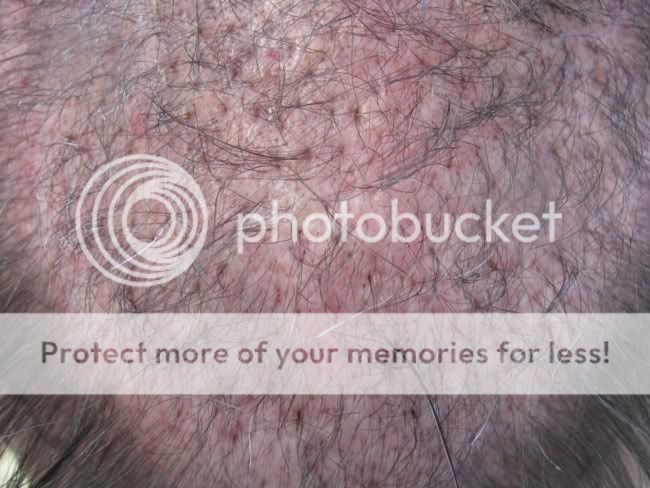


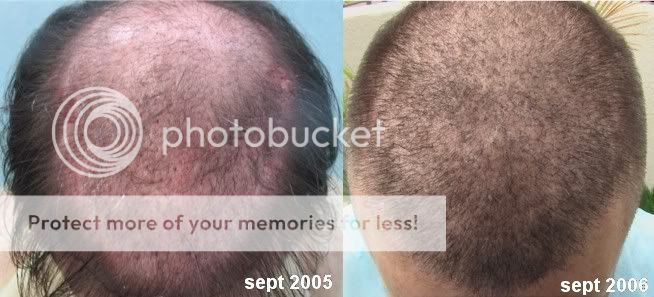
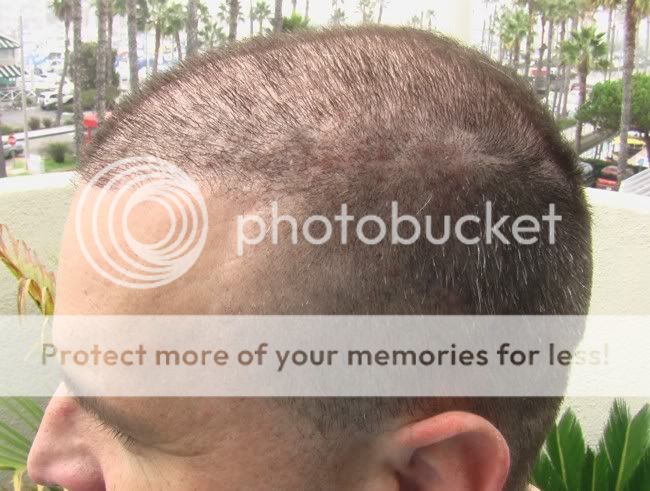
The archive is replete with examples of dirty tactics by competing clinics.
I am sure patients would rather not wait 5 years to determine outcome of their HT regardless of the donor source.
S. Umar, M.D., FAAD
DermHair Clinic
Redondo Beach, California
+1-310-318-1500
1-877-DERMHAIR (US residents)
info@dermhairclinic.com
NEW WEBSITE www.dermhairclinic.com
Single Follicule Extraction & Transfer (SFET)
Using Head and Body hair
For more SFET-FUE and BHT results go to www.dermhairclinic.com
Dr. Umar, there is no attempt at dirty tactics on my part. The point very simply is that all forms of FUE leave white dots in patients prone to these. Individuals with white hair will not get them usually and there are some others who do not get them. The risk is not predictable just like the risk of strip scar width is not predictable prior to surgery. The white dots are due to an absence of pigment and circulation rather than technique. White dots do not appear on the back or lower extremities. They occassionally appear on the chest.
Someone has given this patient the opinion that my procedure caused him to form white dots and that it must be due to my technique. It certainly was not me. Since he did not ever bring this up to me prior to his procedure with you, one can only guess where he derived this conclusion. I certainly have no crystal ball.
I have some very good photos showing quite a bit of density and none of this redness on the scalp. Was that prior to his procedure with you or after. If after, one would suspect quite a bit of shock loss.
Incidentally, those pitted grafts were there prior to his work with me. They are not my handy work.
My work focused on the hair line and removal of some of the pitted grafts.
In the end it is a good result and the patient is happy. That is what matters most.
Dr Cole
I appreciate you being thorough with the explanation of your study. I find it very hard to comprehend based on my own experiences that the variation in punch sizes does not have some impact on the potential of cosmetically visible dotting.
In regards to the hairline work that you did the transplanted hair did grow in and was useful in front of my hairpiece at that time which was my goal. At that time before BHT became a viable option I thought I would have to wear an hairpiece the rest of my life and thought a natural hairline would offer some balance . I made no reference to that transplanted hair not growing and serving its purpose in front of my hairpiece . Since that time alot of work has been done to further restore my hairline since removal of my hairpiece following successful restoration .
Any hair that I had prior to my BHT work was shown in my immediate before pic behind the hairline that you transplanted. I left the transplanted hairline you performed and the hair behind it uncut ,unshaved for the purpose of showing the variation of coverage that existed before I started my BHT restoration .
You have helped many patients and this is well known . I responded to this thread based on the conclusion comments in your study stating punch sizes do not matter. The forums are used by many to research their options and stimulate questions/inquires /advantages /disadvantages for undergoing transplants . Your study provokes alot of thought which scares me to some extent for the potential candidate researching scarring potential with FUE but you have stated your study conclusions as you see them and have experienced .
19,000 grafts by Dr Umar
www.myhairtransformation.com
Dr. Cole,
Very interesting study. If your FIT/CIT technique leaves the donor area without noticeable scarring or indication a graft has been removed, then why do you provide FIT farming to replace the harvested grafts. Why do you feel the need to replace the excised tissue if there is no indication you harvest from that area?
I will be displaying donor and recipient photos over the next few posts. While some have been recommending small or smaller punches for over four years, IHTI has been putting up one result after another.
This is a result of a 6102 graft FIT/CIT session. This surgery was performed with 5135 grafts extracted from the scalp and 967 grafts extracted from the body. A large number of follicular units were required to properly treat this individual’s Class 6 hair loss pattern. In this case the follicular density of the donor area was slightly better than average (80-90 fu/cm2) which enabled a 5000+ scalp FIT harvest in a single pass. The remaining grafts were harvested from the legs and placed in the perimeter of the crown. The results are very impressing and the patient is very satisfied. Here are clear pre-operative and follow-up photos below.

My advice is not medical advice.
» Dr. Cole,
» Very interesting study. If your FIT/CIT technique leaves the donor area
» without noticeable scarring or indication a graft has been removed, then
» why do you provide FIT farming to replace the harvested grafts. Why do
» you feel the need to replace the excised tissue if there is no indication
» you harvest from that area?
Regardless of what size punch is used, once a graft is extracted, the donor density will be compromised. Hair farming will be useful for filling in the empty space between grafts and diminish the thinning look.
CIT,
Nice photos. May we see his procedure photos immediately post op for the scalp also?
Here we have a class 3V with dark brown medium caliber hair and a medium skin tone. He has a follicular density of 90 at the left mastoid and a hair density of 210 at the left mastoid. He underwent a 3 day session of FIT to the frontal 1/3rd of his scalp.
My advice is not medical advice
This is a good example of a patient (white hair with white skin) who would not get white dotting–at least not visible. The reason is simple, no contrast between the areas of hair and the areas of extraction, or absence of hair.
That cannot be said of other patients with darker complexion and/or hair in the donor. The absence of hair will leave contrast to the naked eye and create the infamous white dotting. Again, it might not be true scarring, or any different whether 0.75 or 1.00 mm punch is used, but simply the contrast created by the absence of hair at various locations whereas the surroundings have hair.
Natural thinning occurs in a pattern that usually does not create absence of hair contrast. However, donor harvesting cannot emulate nature’s thinning it seems so far, since so many FUE-ed donors have this white dotting issue. The punch size is really psychological for most cases. The real issue is the unnatural pattern or contrast created by absence of hair, rather than any scarring. That is the improvement that is needed in the industry, to emulate natural thinning rather than geometrical discernible white gaps in space of dark background.
If you take a virgin scalp donor, then use photoshoot to eliminate 3-4000 single hairs, you will see that there will be white dotting. Does it mean that the patient had scarring because of photoediting? No, simply there is now white gaps in a dark background, that, simply, sticks out. Nothing to do about it other than grafting in those to break that pattern, or make it naturally thin as in normal thinning.
» Regardless of what size punch is used, once a graft is extracted, the
» donor density will be compromised. Hair farming will be useful for filling
» in the empty space between grafts and diminish the thinning look.
I think there is a reasonable arguement that a larger punch has the danger of damaging the surrounding follicles. This effect was coined by Dr. Woods as “devils halo”.
In as much as there is a risk to the extracted graft by smaller punches there is therefore a risk identified by Dr. Woods to several surrounding follicles which logically would be effected more by larger punches. These white dot are most notible in this scenario.
Ofcause this may depend on the skill of a particular surgeon.
I think Dr. Bisanga performed a study for “peripheral transections”.
» This is a good example of a patient (white hair with white skin) who would
» not get white dotting–at least not visible. The reason is simple, no
» contrast between the areas of hair and the areas of extraction, or absence
» of hair.
»
» That cannot be said of other patients with darker complexion and/or hair
» in the donor. The absence of hair will leave contrast to the naked eye and
» create the infamous white dotting. Again, it might not be true scarring, or
» any different whether 0.75 or 1.00 mm punch is used, but simply the
» contrast created by the absence of hair at various locations whereas the
» surroundings have hair.
»
» Natural thinning occurs in a pattern that usually does not create absence
» of hair contrast. However, donor harvesting cannot emulate nature’s
» thinning it seems so far, since so many FUE-ed donors have this white
» dotting issue. The punch size is really psychological for most cases. The
» real issue is the unnatural pattern or contrast created by absence of
» hair, rather than any scarring. That is the improvement that is needed in
» the industry, to emulate natural thinning rather than geometrical
» discernible white gaps in space of dark background.
»
» If you take a virgin scalp donor, then use photoshoot to eliminate 3-4000
» single hairs, you will see that there will be white dotting. Does it mean
» that the patient had scarring because of photoediting? No, simply there is
» now white gaps in a dark background, that, simply, sticks out. Nothing to
» do about it other than grafting in those to break that pattern, or make it
» naturally thin as in normal thinning.
We performed on this patient more than 1300+ FIT grafts from the scalp and 1000+ body FIT grafts from the chest. These follow-up photos are completely shaved unlike his pre-operative photos. The patient has a very thin donor area and some scars on his donor over the back of his head. It is nearly impossible to take grafts with a strip procedure. This patient’s only solution was to do a follicular isolation technique procedure with his body hair. Fortunately, he had a viable source of chest hair to add coverage to his scalp. His healing very well after just approx. 45 days and is expected to be better in weeks to come.
My advice is not medical advice
» I think Dr. Bisanga performed a study for “peripheral transections”.
How could you possibl do that without taking a biopsy???

